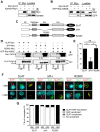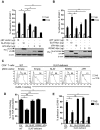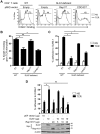SLAT promotes TCR-mediated, Rap1-dependent LFA-1 activation and adhesion through interaction of its PH domain with Rap1
- PMID: 26483383
- PMCID: PMC4712813
- DOI: 10.1242/jcs.172742
SLAT promotes TCR-mediated, Rap1-dependent LFA-1 activation and adhesion through interaction of its PH domain with Rap1
Abstract
SLAT (also known as DEF6) promotes T cell activation and differentiation by regulating NFAT-Ca(2+) signaling. However, its role in TCR-mediated inside-out signaling, which induces integrin activation and T cell adhesion, a central process in T cell immunity and inflammation, has not been explored. Here, we show that SLAT is crucial for TCR-induced adhesion to ICAM-1 and affinity maturation of LFA-1 in CD4(+) T cells. Mechanistic studies revealed that SLAT interacts, through its PH domain, with a key component of inside-out signaling, namely the active form of the small GTPase Rap1 (which has two isoforms, Rap1A and Rap1B). This interaction has been further shown to facilitate the interdependent recruitment of Rap1 and SLAT to the T cell immunological synapse upon TCR engagement. Furthermore, a SLAT mutant lacking its PH domain drastically inhibited LFA-1 activation and CD4(+) T cell adhesion. Finally, we established that a constitutively active form of Rap1, which is present at the plasma membrane, rescues the defective LFA-1 activation and ICAM-1 adhesion in SLAT-deficient (Def6(-/-)) T cells. These findings ascribe a new function to SLAT, and identify Rap1 as a target of SLAT function in TCR-mediated inside-out signaling.
Keywords: Def6; Immunological synapse; Inside-out signaling; Integrin activation; Rap1; SLAT; T cell-adhesion.
© 2015. Published by The Company of Biologists Ltd.
Conflict of interest statement
The authors declare no competing or financial interests.
Figures





Similar articles
-
RIAM links the ADAP/SKAP-55 signaling module to Rap1, facilitating T-cell-receptor-mediated integrin activation.Mol Cell Biol. 2007 Jun;27(11):4070-81. doi: 10.1128/MCB.02011-06. Epub 2007 Apr 2. Mol Cell Biol. 2007. PMID: 17403904 Free PMC article.
-
HPK1 competes with ADAP for SLP-76 binding and via Rap1 negatively affects T-cell adhesion.Eur J Immunol. 2010 Nov;40(11):3220-5. doi: 10.1002/eji.201040313. Eur J Immunol. 2010. PMID: 20957749
-
Ubc9 Binds to ADAP and Is Required for Rap1 Membrane Recruitment, Rac1 Activation, and Integrin-Mediated T Cell Adhesion.J Immunol. 2017 Dec 15;199(12):4142-4154. doi: 10.4049/jimmunol.1700572. Epub 2017 Nov 10. J Immunol. 2017. PMID: 29127148
-
Small GTPases and LFA-1 reciprocally modulate adhesion and signaling.Immunol Rev. 2007 Aug;218:114-25. doi: 10.1111/j.1600-065X.2007.00538.x. Immunol Rev. 2007. PMID: 17624948 Review.
-
Regulation of lymphocyte adhesion and migration by the small GTPase Rap1 and its effector molecule, RAPL.Immunol Lett. 2004 Apr 30;93(1):1-5. doi: 10.1016/j.imlet.2004.02.008. Immunol Lett. 2004. PMID: 15134891 Review.
Cited by
-
Identification of a Novel Alternatively Spliced Form of Inflammatory Regulator SWAP-70-Like Adapter of T Cells.Int J Inflam. 2017;2017:1324735. doi: 10.1155/2017/1324735. Epub 2017 Apr 24. Int J Inflam. 2017. PMID: 28523202 Free PMC article.
-
Integrin Regulators in Neutrophils.Cells. 2022 Jun 25;11(13):2025. doi: 10.3390/cells11132025. Cells. 2022. PMID: 35805108 Free PMC article. Review.
-
Human DEF6 deficiency underlies an immunodeficiency syndrome with systemic autoimmunity and aberrant CTLA-4 homeostasis.Nat Commun. 2019 Jul 15;10(1):3106. doi: 10.1038/s41467-019-10812-x. Nat Commun. 2019. PMID: 31308374 Free PMC article.
-
Leukocyte arrest: Biomechanics and molecular mechanisms of β2 integrin activation.Biorheology. 2015;52(5-6):353-77. doi: 10.3233/BIR-15085. Biorheology. 2015. PMID: 26684674 Free PMC article. Review.
-
The tyrosine phosphatase SHP-1 promotes T cell adhesion by activating the adaptor protein CrkII in the immunological synapse.Sci Signal. 2017 Aug 8;10(491):eaal2880. doi: 10.1126/scisignal.aal2880. Sci Signal. 2017. PMID: 28790195 Free PMC article.
References
-
- Baumeister M. A., Martinu L., Rossman K. L., Sondek J., Lemmon M. A. and Chou M. M. (2003). Loss of phosphatidylinositol 3-phosphate binding by the C-terminal Tiam-1 pleckstrin homology domain prevents in vivo Rac1 activation without affecting membrane targeting. J. Biol. Chem. 278, 11457-11464. 10.1074/jbc.M211901200 - DOI - PubMed
Publication types
MeSH terms
Substances
Grants and funding
LinkOut - more resources
Full Text Sources
Other Literature Sources
Research Materials
Miscellaneous

